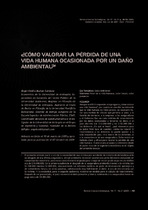| dc.contributor.author | Muñoz Cardona, Ángel Emilio | |
| dc.coverage.spatial | Seccional Medellín | spa |
| dc.date.accessioned | 2021-01-20T13:21:35Z | |
| dc.date.available | 2021-01-20T13:21:35Z | |
| dc.date.issued | 2009 | |
| dc.identifier.issn | 1794-8347 | |
| dc.identifier.uri | http://hdl.handle.net/20.500.11912/7457 | |
| dc.description | p. 49 - 56 | spa |
| dc.description.abstract | Aunque es difícil responder a la pregunta ¿cómo valorar una vida humana?, por cuanto se concibe socialmente que la vida humana no tiene precio, es necesario hallar una medida de cálculo que permita al juez, a la familia del doliente, a la empresa, a las aseguradoras y al Gobierno fijar un valor mínimo de resarcimiento por los daños ocasionados a terceros. Es decir, si el juez decreta dar $10.000.000 y no $100.000.000 a los dolientes ¿En qué se basó?, ¿qué elementos para su juicio final tuvo en cuenta?, ¿cómo los valoró? El resarcimiento a los dolientes no puede quedar a la sola simpatía del juez, ni al teatro de los dolientes, ni a la conveniencia de una aseguradora. Debe existir un método claro y eficaz para valorar la pérdida de una vida humana. Elaborar una propuesta coherente desde el punto vista de la ingeniería económica es el objeto del presente ensayo. | spa |
| dc.description.abstract | Although it is difficult to answer the question how to value a human life?, Socially conceived as human life is priceless, is necessary to find a calculation that allows the judge to the family of the bereaved, to the company, to insurers and the government set a minimum value of compensation for damage caused to third parties. That is if the judge ordered to give $ 10,000,000 to $ 100,000,000 and not what the mourners went, what elements of their final verdict took into account, how the value? Compensation to the bereaved can not be the sole judge of sympathy, or the theater of the mourners, or the desirability of an insurer. There must be a clear and effective method for assessing the loss of human life. Develop a coherent proposal in terms of economic engineering is the subject of this essay. | spa |
| dc.format.mimetype | application/pdf | |
| dc.language.iso | spa | |
| dc.publisher | Universidad Pontificia Bolivariana | spa |
| dc.relation.ispartof | Revista Ciencias Estratégicas | spa |
| dc.rights | Attribution-NonCommercial-NoDerivatives 4.0 International | * |
| dc.rights.uri | http://creativecommons.org/licenses/by-nc-nd/4.0/ | * |
| dc.subject | Externalidad negativa | spa |
| dc.subject | Valor futuro | spa |
| dc.subject | Valor presente | spa |
| dc.subject | Anualidad de una cuota | spa |
| dc.subject | Ingeniería económica | spa |
| dc.subject | Negative externality | spa |
| dc.subject | Future value | spa |
| dc.subject | Present value | spa |
| dc.subject | Annuity fees | spa |
| dc.subject | Economic engineering | spa |
| dc.title | ¿Cómo valorar la pérdida de una vida humana ocasionada por un daño ambiental? | spa |
| dc.type | article | spa |
| dc.rights.accessRights | openAccess | spa |
| dc.type.hasVersion | publishedVersion | spa |
| dc.description.sectional | Medellín | spa |
| dc.identifier.instname | instname:Universidad Pontificia Bolivariana | spa |
| dc.identifier.reponame | reponame:Repositorio Institucional de la Universidad Pontificia Bolivariana | spa |
| dc.identifier.repourl | repourl:https://repository.unab.edu.co/ | |


